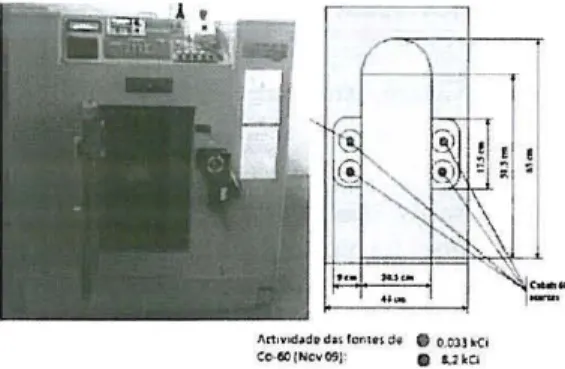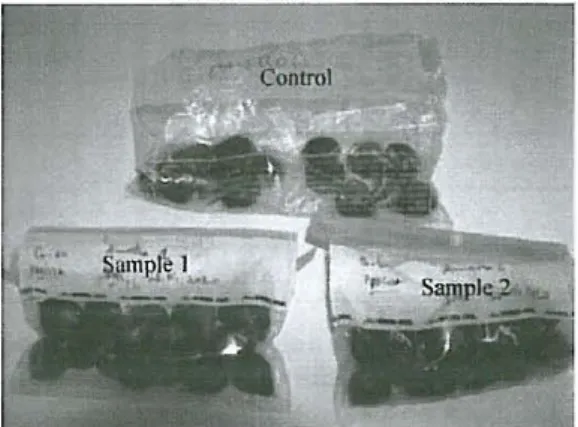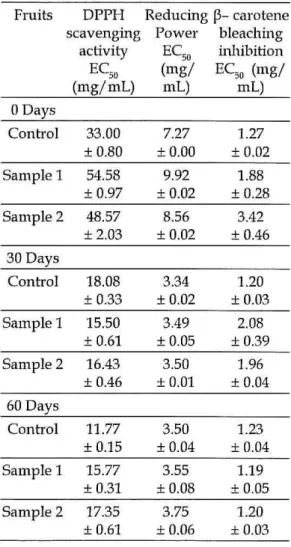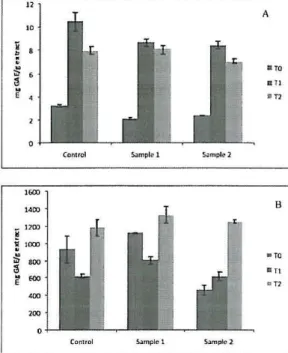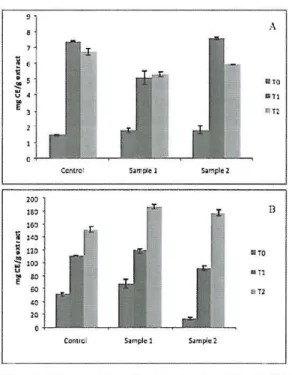NAARRI INTERNATIONAL CONFERENCE - 2010
(NIC-2010)
Isotope Technologies and Applications
-New Horizons
Oecember 13 - 15, 2010
Hotel Renaissance, Powai, Mumbai
VOLUME II
CONTRIBUTED PAPERS
Organized by
National Association for Applications of Radioisotopes &
Radiation in Industry
(NAARRI)
NIC-201O FT-05
Influence of gamma radiation on the antioxidant properties of
edible chestnuts
A. L. António", L C. F. R. Ferreira", A. Bento", P. Teubig ", M. Luísa Botelho"
n CIMO/Agricultural 5c11001, PolytecJmic lnsh'hlfe o/Bragança, Campus de Santa Apolónia,
5301-855 Bragança, Portugal.
lamilcar@jpb.pl;2iferreira@jpb.pt; 3bento@jpb.pt
. Uni! Df Physics {l1ld Accelerators, Nuclear and TecJ111ological Inshhde
Estrada Naciollal10, 2686-953 Sacavém. Portugal 'pteubig@jpt.pt;5mlb@itn.pt
Abstract
As seasonal products chestnut have to be postharvest treated to illcrease the shelf-life.
Several problems are associated with tradítional preservation rnethods. These are a
decreasing in quality due to dehydration and contamination with insects and microbes
includingsecondary metabolites, e.g.: mycotoxin. The most common preservation method
for chestnuts is the use ofchemical fumigalion with methyI bromide. Methyl bromide is a toxic agellt and has been balUled according to the Montreal Protocol due to its adverse effects on human health and the environment. Following the recommendalions of a scientific committee of the United Nations Enviromnental Program (UNEP), Methyl Bromide Tecluücal Options Committee (MBTOC), food irradiation is a possible feasible option. This pre1iminary study evaluated the influence of gamma irradiation in the antioxidant potential of chestnut fruits and skins. Results showed that irradiation of chestnuts at low irradiation doses, 0.27 kGy and 0.54 kGy, could affected the skin and
fruit properties differentIy.
Keywords: Castal1ea sativa Mill.; lrradiated chestnut; Gamma irradiation; Antioxidant aclivity.
Introduction
There are !WO main problems related to
chestnuts preservation: weight losses due to dehydration and development of insects and microorganisms. Methyl bromide (MeBr) fumigation has been used traditional1y for chestnuts preservation. However, according to Montreal Protocol it was banned due to their harmful environment and health effects.
Another alternative conservation process is
heat b'eatment, bu t it is time consuming and has a low efficiency, Therefore, an alternative
conservation process is urgently needed. Food irradiation has been successfully used
for fruit disinfestations [1], [5], [12], This teclmique has recently been considered as
an alternative to fumigation, as it reduces
considerably the amount of product lost during post-harvest period due to rotting, resulting from the development of fungi and moulds. Also, this technology is environmental1y friendly, in conb'ast to tlle
b'aditional use of fumigants (e.g.: methyl
bromide), not leaving any type of chemical
residues on fruits or environrnent.
Nevertheless, irradiation is a method tllat
must be studied in detail, since the results vary significantly within different fruit species, exposure time (doses) and geometry (dose uniformity) [6], [7].
N/C-20l0
nothing h05 been reported. Furthermore, our research group has reported the antioxidant
potential of different extracts of Costollea
sativa Mill. (flowers, leaves, skins and fruits)
[8] . Herein, we describe the influence of irradiation process (two different doses) in antioxidant properties of fruits and skins stored at 4 °C for 2 months.
Methodology
Samples. Chestnut cv. Longal sam pIes
were obtained fram Trás-as-Montes, in the Northeast of Portugal. Chestnuts were divided in three samples (conh'ol, sam pie 1, sam pie 2) with fifteen units per sam pIe.
Irradiation. The irradiations were
performed in a 6OCO experimental equipment (Precisa22, Graviner Lda, UK). Sam pIe 1 was irradiated 1 h and sam pIe 2 was irradiated
2 h.
IIn,..c!.d .d .. lo'''., :k • O , ~l l "I
~!Nc~C91 · • •• HO
Fig. 1 - Irradiatioll c/Iamber: oetivihj of sourees
ond dimensiolls [7J
The 6OCO irradiation facility, shown in Fig. 1, consists of a rectangular cavity with the following dimension: 65 cm x 50 cm x 20 cm (h x d x w) and surrounded with a lead
protection barrier. Four 6OCO sources, with an
activity of 305 TBq (8.233 kCi) in November 2009, are positioned in stainless-steel tubes located in the lateral walls of the chamber, in positions directly facing each otller, about 30 cm above the chamber floor. The movement
of the SOUl'ces in the 50 cm long tubes is conh'olled by an automatic mechanism.
A dosimetric study was performed using Fricke solution as reference dosimeter, witllin tlle range of 40 to 400 Gy. The Fricke dosimeter is widely used in the calibration of radiation processing and provides a reliable
means of absorbed doses measurenlent in
watef, based on an oxidation process of
ferrous ions to ferric ions in acidic aqueous solution by ionizing radiation. The change in absorbance Df the solution was lueasured using a spech'ophotometer at 305 nm [9], [10], [11].
Five dosimeters of pyrex glass tubes witll 15 mL of the Fricke solution were used. This dosirneter volulne was chosen in accordance with tlle tllickness of chestnut fruit samples.
Irradiations were performed on the 4th leveI
of the cobalt-60 experimental chamber at the corners and tlle centre of the rectangle (the approximately area occupied by the sam pie bag).
Fricke solutions were placed on the corners and central points of a rectangle wooden tray at positions equal to the position of the sam pie bags (as shown in Fig. 2).
Aftel' irradiation, the absorbance, Ai,
of the irradiated solution was determined
..
12 cm
(0,
NIC-201O
using a spectrophotometer (Shimadzu mini UV 1240) at 305 nm, using a non-irradiated solution as a reference blank.
The equation used for estimating the absorbed dose, O:
275x "- A
D= - C=-- ~~~
1+ 0.007 (T - 25) (Gy)
where /lA is the difference in absorbance
at 305 nm, between the irradiated and
the non-irradiated solution and T is the
solution temperature (in 0c) during the spech'ophotornetric measurernents.
After irradiation geometry dose rate estimation, the chestnut samples 1 and 2 were placed into plastic bags and irradiated for 1 h and 2 h , respectively.
A/ltioxida/ll activillj assaljs. The sam pies
were stored at 4 °C for O days, 30 days and
60 days. A sub-sample fram each of the treatrnents was obtained at each time point and analyzed (control, sam pie 1, sample 2 - Fig. 3).
Fruits were separated Irom the skins (Fig. 3) and the samples were dried in an oven at
- 30
oe.
A fine dried powder (20 mesh) (1.5g) was extracted twice with methanol (30 mL) for 1 h. After filtration and evaporation of the methanol, the extracts were re-dissolved in methanol at a concentration of 20 mg/ mL and analysed for phenolics and flavonoids contents, DPPH (2,2-diphenyl-1-picrylhydrazyl) radical scavenging activity,
reducing power and inhibition of ~-carotene
bleaching [8].
Total phenolics were determined by the Foli/l-Ciocalteu colorimetric assay [8]. Total flavonoids were determined spectrophotometrically using the method based on the formation of a complex flavonoid-aluminum [8]. Results were
expressed as gallic acid equivalents (GAE) and catechin equivalents (CE), respectively.
DPPH radical-scavenging activity was measured using an ELX800 Microplate Reader (Bio-Tek Instruments, Inc). The
reaction mixture consisted Df extract solution
and aqueous methanolic solution containing DPPH radicais. The mixture was left to stand for 60 min in the dark. The reduction of the DPPH radical was determined by measuring the absorption at 515 nm. The presence of reducers (i.e. antioxidants) causes the conversion of the Fe" / ferricyanide complex used in this method to the ferrous formo Therefore, by measuring the formation of Perl' s Prussian blue at 700 nm we can monitor
the Fe2-1- concenb'ation; a higher absorbance
at 700 nm indicates a higher reducing
power. Decolourization of ~-carotene was
monitored spectrophotometrically at 470
nm. The ~-carotene undergoes a rapid
discoloration in the absence of an antioxidant since the free linoleic acid radical attacks the ~-carotene molecule, which looses the double bonds and, consequently, looses its characteristic orange colour. Classical antioxidants can donate hydrogen atoms to quench radicais and prevent decolourization of carotenoids [8].
.
,J,
-
-Fig. 3 - ChestnJ/ls sm/lples: Control (willzout
NIC-201O
J. M . amplo ;!,
Fig. 4: Chestnllts after peeling: Contrai (withollt irradintioll), Sn11lple 1 (0.27 kGy), Snmple 2 (0.54kGy)
ResuIts and Discussion
A. lrradintioll
An estimation of dose was performed using Fricke chemical dosimeter saIu tion as described above.
The estimated values for the different positions are presented in Table 1.
TABLE 1: Dose distribution
Position Dose rate
(kGy!h)
1 0.30
2 0.29
3 0.29
4 0.23
5 0.23
D l1lean 0.27 ± 0.04
ln this experimental setup, the dose
uniformity ratia, the ratio Df maximum to
minimum absorbed dose in the production
lat, obtained is similar to one (Dma)Dmin =
1.3).
Sarnples were exposed to 1 and 2 h of irradiation, therefore, using the average dose rate this would equivalent to 0.27 and 0.54 kGy, respectively.
B. Antioxidant potentinl
The chestnut skins had higher phenolic and flavonoid contents (Fig. 5 and 6), as well as higher antioxidant activity (Iower
EC50 values) than chestnut fruits (Table 2
and Table 3), which is in agreement to oU]' previous results [8J.
Table 2: Anti-oxidant activity in fruits
Fruits DPPH Reducing
p-
cal'Otenescavenging POW€l' bleaching
activity EC50 inhibition
EC" (rng! EC50 (rng!
(rng!rnL) rnL) mL)
O Days
Control 33.00 7.27 1.27
± 0.80 ± 0.00 ± 0.02
Sarnple 1 54.58 9.92 1.88
± 0.97 ± 0.02 ± 0.28
Sample 2 48.57 8.56 3.42
±2.03 ± 0.02 ± 0.46
30 Days
Control 18.08 3.34 1.20
± 0.33 ± 0.02 ± 0.03
Sample 1 15.50 3.49 2.08
± 0.61 ± 0.05 ± 0.39
Sample 2 16.43 3.50 1.96
± 0.46 ± 0.01 ± 0.04
60 Days
Control 11.77 3.50 1.23
± 0.15 ±0.04 ± 0.04
Sample 1 15.77 3.55 1.19
± 0.31 ±0.08 ± 0.05
Sarnple 2 17.35 3.75 1.20
NIC-2010
Table 3: Anti-oxidant activity in skins
skins
o
DaysControl
sample 1
Sam pIe 2
30 Days Control
sample 1
sample 2
60 Days Control
sample 1
sample 2
DPPH Reducing
p-scavenging Power carotene
activity ECso ECso bleaching
(mg/mL) (mg/ l11L)inhibition
ECso
(l11g/ mL)
57.22 33.52 46.42
±4.84 ± 0.02 ± 2.88
97.30 53.46 27.21
± 2,77 ± 0.08 ± 0,00
46.42 27.21 59.41
± 2.87 ± 0.00 ± 0.08
43.49 26.32 241.97
±3.13 ± 3.41 ± 8.02
49.32 28.09 199.83
±0.37 ± 0.18 ± 9.24
38.00 22.62 44.16
±0.83 ± 0.18 ± 5.90
33.91 23.32 95.93
± 1.49 ± 0.71 ±4.97
33.59 22.50 73.78
± 1.40 ± 0.91 ± 6.57
29.10 21 .96 47.49
± 0.74 ± 0.49 ± 1.99
The flavonoid content of both skin and fruit showed the same tendency for non-irradiated and for the irradiation treatments (0.27 and 0.54 kGy) during the entire storage (O days, 30 days and 60 days) The phenolic and antioxidant potential content of the skins increased after a dose of 0.27 kGy and a decrease after 0.54 kGy of irradiation in comparison to the control sam pIe at day O. Irradiated fruits revealed a decrease in phenolic content and antioxidant potential relatively to control. The gal11ma radiation
dose used (sample 1, 0.27 ± 0.04 kGy; sam pIe
2,0.54 ± 0.04 kGy) did not shown significant
influence in those parameters. Along stOl'age (up to 60 days) the studied parameters followed the same tendency in control and irradiated sam pIe fruits.
The results indicate that the dose of 0.27 kGy of irradiation seemed to be more adequate to maintain antioxidant potential of skins than the dose of 0.54 kGy. Tlle higher dose decreased the antioxidant potential of the fruits .
condusions
ln food irradiation the dose distribution inside the chamber and the dose uniformity ratio must be well characterized to control
the irradiation processo
The results highlighted that the material could be rotated to obtain a better uniform
dose, as is a standard practice in cOlnulercial
units. However, the dose uniformity ratio
"
"
"ro
"""
~ 1200
~ l OCO
;li "",
~
e "'"
""
o
C0 01'01
A
.ro
.,.
. "
B
· ro
. ,.
."
Fig. 5 - Phenolic content;/l elzest/lllt fruits (A)
n/ld sleins (B); TO - O dnys;
NIC-201O
of Portugal with the Project na 13198/2010
A "CHESTNUTSRAD -An a!temative tream,ent
for chestllllts preseruatioll".
,
,
i
~ s
u •
~
'"
",
",
ii 1<0
~ 110
~ 100
u E '"
"
lOTI
."
-"
. "
Con\te! S.mple l S.mpl e<
Fig. 6 -Flavonoid conten tin chesmut fruits (A)
and skillS (B): TO - O days;
Tl - 30 days; T2 - 60 days
abtained is in confarmity with the gaad practices for faad irradiation.
ln this preliminary study we can suggest
that a variatian af 0.27 kGy cauld affect the
skin and fruit properties in different ways, maybe due to different chenúcal composition of these parts. However, alang storage time the contrai and irradiated samples follow the same tendency. Further studies will be clone in arder to elucidate the influence of irradiation in chemical composition and nutritional value of chestnuts fruits. The study will be extended to include ali positions in the irradiation chamber and to consider more expose doses.
Acknowledgment
This work was supported in part by the Ministry of Economy and lnnavatian
References
1. UNEP, Montreal ProtocoI on substances that
deplete the ozone layer: Report of the Methyl
Bromide Teclutical Options Committee, pp.
205-206,310-313,2006.
2. WHO - Warld Health Organization, Safety
and nutritional adequacy of irradiated foad, Geneva:,1994.
3. Directivel999/2/EC (22deFeblUary de 1999).
Directive Df the European Parliament and Df
the CounciI. O) L 66 of13.03.1999.
4. CODEXST AN 106-1983. General Standard for lrradiated Food. pp. 1-3, rev.1-2003
5. CAC/RCPl9-1979Rev2(2003).Recommended
lntemational Code Df Practice for Radiation
Processing of Food. pp. 1-7, 2003.
6. ). Kim, R. Moreira, Y. Huang, M. Castell-Perez,
3-D dose distributiol1s for optimum radiation
treatment planning af complex foods. J. Food
Eng. 79, pp. 312-321, 2007.
7. A. Belchior, M. L Botelho, P. Vaz, MonteCarlo
simulations and dosimetric studies af an
irraruation facility. Nuclear lnstruments and
Methods in Physics Research A 580 pp. 70-72, 2007.
8. ).CM. Barreira, I.CF.R. Ferreira, M.B.P.P.
Oliveira, J.A. Pereira. Antioxidantactivities Df
the extracts fram chestnut flower, leat skins
and nuit. Food Chemistry 107, pp.1106-1113, 2008.
9. IAEA, Dosimetry for food irradiation,
Technical Report Series na 409, lntemational
Atomic Energy Agency, 2002
10. AMERICAN SOCIETY FOR TESTING ANO MATERIALS, Practice for Using the Fricke Reference Standard Dosimetry Sysrem, ASTM EI026, Annual Book of ASTM Standards, VoI. 12.02, Philadelphia, PA, 2000.
11. K. Sehested, The Flicke Dosemeter, N. H. Bary Ed., NewYork, MarcelDekker, 1970
12. P. Pinto, S. Cabo Verde, M.). Trigo, A. Santana
M. L. Botelho. Food Irradiation: Microbiat
Nutritional" and Functional Assessment. ln
Radionuc1ide Concentrations in Food and the Environrnent. CRC Taylor & Francis. Pp.
